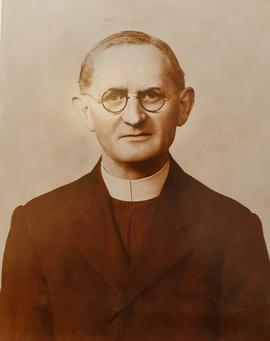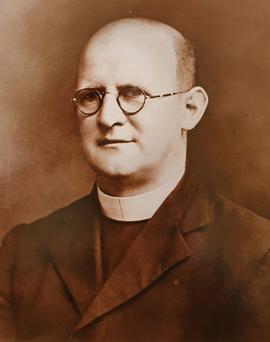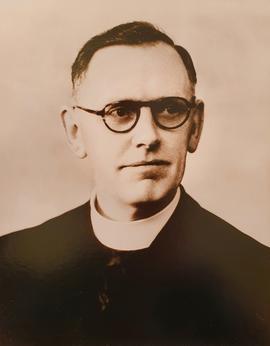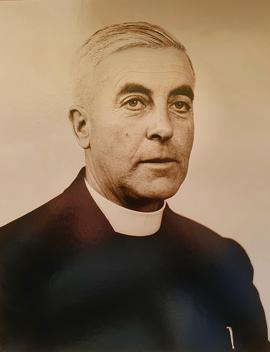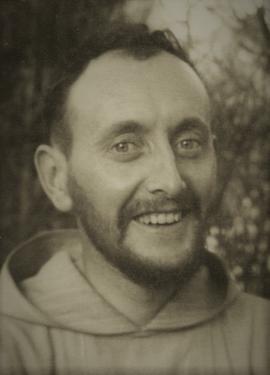Born: 17 March 1890 in Dromin, Killorglin, County Kerry
Reception: 23 December 1907, Mount St Joseph, Cork
Professed: 27 March 1910
Died: 13 June 1981
Interred: Blessed Edmund Rice Cemetery, Mount St Joseph, Cork
Born: 11 March 1892 in Fortel, Birr, County Offaly
Entered novitiate: 6 January 1909, Mount St Joseph, Cork
Reception: 12 September 1909
Professed: 7 April 1912
Died: 11 March 1958, Mount St Joseph, Cork
Interred: Blessed Edmund Rice Cemetery, Mount St Joseph, Cork
Born: 18 March 1905 in Mount Collins, County Limerick
Entered novitiate: 10 September 1921, Mount St Joseph, Cork
Reception: 29 June 1922
Professed: 29 June 1924
Died: 3 July 1989
Interred: Blessed Edmund Rice Cemetery, Mount St Joseph, Cork
Born: 19 June 1914 in Bunadreen, Mastergreehy, Waterville, County Kerry
Entered juniorate: 28 August 1930, Coláiste Muire, Douglas, Cork
Reception: 16 July 1934
Professed: 12 July 1936
Died: 15 October 2001
Interred: Blessed Edmund Rice Cemetery, Mount St Joseph, Cork
Baptismal name: Nicholas John Dillane
Religious name: Fr. Raymond Dillane OFM Cap.
Date of birth: 22 Feb. 1916
Place of birth: North Circular Road, Dublin
Name of father: James Dillane (Prison Warder)
Name of mother: Mary Dillane (née Kenny)
Date of reception into the Capuchin Order: 3 Oct. 1937
Date of first profession: 4 Oct. 1938
Date of final profession: 4 Oct. 1941
Date of ordination (as priest): 29 June 1945
Missionary activities: Travelled to Barotseland, Northern Rhodesia (later Zambia), on 21 Feb. 1946. Transferred to the Cape Town Mission, South Africa, in 1968. He returned to Ireland on 15 Nov. 1991.
Date of death: 10 Jan. 1999
Place of death: St. Francis Hospice, Raheny, Dublin
Place of burial: Glasnevin Cemetery, Dublin
Baptismal name: Patrick Carroll
Religious name: Fr. Alphonsus Carroll OFM Cap.
Date of birth: 17 Aug. 1874
Place of birth: Killacolla, County Limerick
Name of father: John Carroll (Farmer)
Name of mother: Elizabeth Carroll (née Barry)
Date of reception into the Capuchin Order: 24 Aug. 1902
Date of first profession: 17 Sept. 1903
Date of final profession: 4 Oct. 1906
Date of ordination (as priest): 5 Sept. 1909
Date of death: 27 Aug. 1934
Place of death: Lindville Hospital, Cork
Place of burial: Cemetery, Rochestown Capuchin Friary, County Cork
John McNamara was born in Glin, County Limerick, on 10 September 1931. He was baptised in the Immaculate Conception Parish Church in Glin in the Diocese of Limerick. He attended the national school in Glin after which he received his secondary education at Rochestown College in County Cork. He was admitted to the Capuchin novitiate in Rochestown on 3 October 1950. Following his temporary profession in Rochestown a year later, he was transferred to St. Bonaventure’s Friary in Cork from where he attended University College Cork for three years, after which he was conferred with a Bachelor of Arts degree. He made his perpetual profession in St. Bonaventure’s on 4 October 1954 and then made his way to Ard Mhuire Friary in Donegal for theological studies. He was ordained to the priesthood by William McNeely, Bishop of Raphoe, in St. Eunan’s Cathedral in Letterkenny on 15 May 1958. Later that year, he commenced Canon Law studies in Rome and obtained a Licentiate in 1960. On 17 August 1960, Fr. Donatus departed for the Irish Capuchin mission in Northern Rhodesia (now Zambia). He first served as assistant pastor in St Therese’s and in Maramba, both in the Livingstone Diocese, from 1960 to 1963. He then went on to teach seminarians in St. John’s in Mongu, in Limulunga and in Nalionwa (Kalabo) from 1964 to 1978. He was rector of the school at Limulunga from 1965 to 1978. He returned to Ireland in 1978, when he became a member of the staff at Rochestown College, teaching there for the next ten years. In 1988 he was appointed Mission Secretary and worked out of the mission office at the Church Street Friary in Dublin. In 1998, he returned to Zambia. He was posted to Malengwa Friary in Mongu, the capital of the Western Province in Zambia, and was appointed chaplain to Mongu Teacher Training College. After a two-year stay (2008-10), in St. Pio Friary, Fr. Donatus was transferred to the recently built Capuchin novitiate at the Camerino Friary in Lusaka, where he lived until his death on 5 July 2021. He was buried in the cemetery attached to the Camerino Friary.
Baptismal name: John McNamara
Religious name: Fr. Donatus McNamara OFM Cap.
Date of birth: 10 Sept. 1931
Place of birth: Glin, County Limerick
Name of father: Thomas McNamara
Name of mother: Brigid McNamara (née Egan)
Date of reception into the Capuchin Order: 3 Oct. 1950
Date of first profession: 4 Oct. 1951
Date of final profession: 4 Oct. 1954
Date of ordination (as priest): 15 May 1958
Educational attainments: BA, 2nd class hons. (1954); Licentiate in Canon Law, Rome (1960)
Missionary activities: Travelled to Livingstone, Northern Rhodesia (later Zambia), on 17 Aug. 1960. He returned to Ireland on 10 Aug. 1976. He returned to Zambia in Sept. 1998.
Date of death: 5 July 2021
Place of death: St. Clare’s Hospital, Makeni, Lusaka, Zambia
Place of burial: Cemetery, Capuchin Novitiate, Camerino Friary, Lusaka, Zambia
Baptismal name: Joseph Fegan
Religious name: Fr. Aengus Fegan OFM Cap.
Date of birth: 16 May 1927
Place of birth: St. Luke’s Cross, Cork
Name of father: Joseph Fegan
Name of mother: Angela Fegan (née Cooke)
Date of reception into the Capuchin Order: 3 Oct. 1948
Date of first profession: 4 Oct. 1949
Date of final profession: 4 Oct. 1959
Date of ordination (as priest): 10 May 1959
Educational attainments: BA (NUI), 1952; Higher Diploma in Education (NUI), 1959
Ministries: Worked in the Capuchin College, Rochestown, County Cork (Secondary School) for most of life teaching art, English, and geography
Date of death: 3 June 2002
Place of burial: Cemetery, Rochestown Capuchin Friary, County Cork
Daniel McFadden was born in Belfast on 4 March 1901. He joined the Capuchin Franciscans in September 1918 and took Declan as his religious name. Following his theological studies, he was ordained to the priesthood in June 1927 and spent his first years in ministry in Holy Trinity Church in Cork. He was among the first friars to volunteer for the Irish Capuchin mission in Cape Town, South Africa (1929), and two years later (October 1931) in the newly established mission territory in Livingstone and Barotseland in Northern Rhodesia (now Zambia). He arrived in Barotseland in 1931 and immediately began to journey (on foot) to remote areas around Sesheke and further afield in Mongu in the western part of the country. Illness brought on by exposure to tropical diseases forced him to return to Ireland in April 1933. He once again volunteered for missionary work in the late 1930s and he made his way to the Archdiocese of Delhi-Simla in India. The Irish Capuchin friar, Fr. Sylvester Mulligan OFM Cap., had been appointed archbishop of this diocese in 1937. Fr. Declan remained in India for eleven years (1937-48). Following his return to Ireland, he was assigned to the Rochestown community in County Cork. Aside from a brief, three-year stint in Kilkenny, he remained in Rochestown for the rest of his life. His ministry included acting as spiritual director for the local Third Order of St. Francis confraternity, organising the church choir, and regular pastoral, preaching, confession, and mission duties. He died on 30 November 1979 and was buried in the cemetery attached to Rochestown Friary.
Baptismal name: Daniel McFadden
Religious name: Fr. Declan McFadden OFM Cap.
Date of birth: 4 Mar. 1901
Place of birth: Limestone Road, Belfast (Diocese of Down and Connor)
Name of father: Daniel McFadden
Name of mother: Mary Ann McFadden (née Burrell)
Date of reception into the Capuchin Order: 29 Sept. 1918
Date of first profession: 4 Oct. 1919
Date of final profession: 4 Oct. 1922
Date of ordination (as priest): 29 June 1927
Academic attainments: BA (1923)
Mission activities: Travelled to Cape Town, South Africa, and later Northern Rhodesia (now Zambia), in 1929. He returned to Ireland from Africa in 1933. He travelled to India in 1937. He returned to Ireland in 1948.
Date of Death: 30 Nov. 1979
Place of death: Cork
Place of burial: Cemetery, Rochestown Capuchin Friary, County Cork
Baptismal name: Francis McConvery
Religious name: Fr. Frederick McConvery OFM Cap.
Date of birth: 11 Jan. 1925
Place of birth: Belfast (Diocese of Down and Connor)
Name of father: Thomas McConvery
Name of mother: Ellen McConvery (née Leonard)
Date of reception into the Capuchin Order: 23 Oct. 1945
Date of first profession: 24 Oct. 1946
Date of final profession: 24 Oct. 1949
Date of ordination: 24 May 1953
Missionary activities: Travelled to Livingstone, Northern Rhodesia (later Zambia), on 26 Aug. 1953
Date of death: 28 Nov. 1968
Place of death: Hermanus, South Africa (*suffered a heart attack whilst swimming off the coast at Hermanus)
Place of burial: Maitland Cemetery, Cape Town, South Africa
